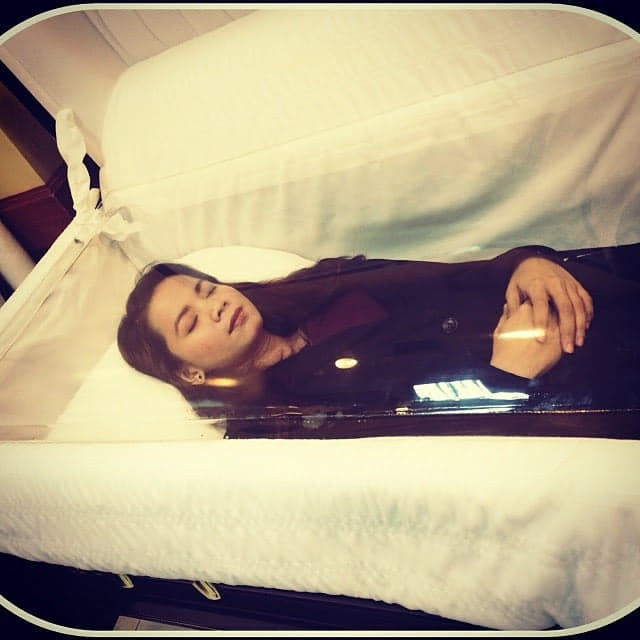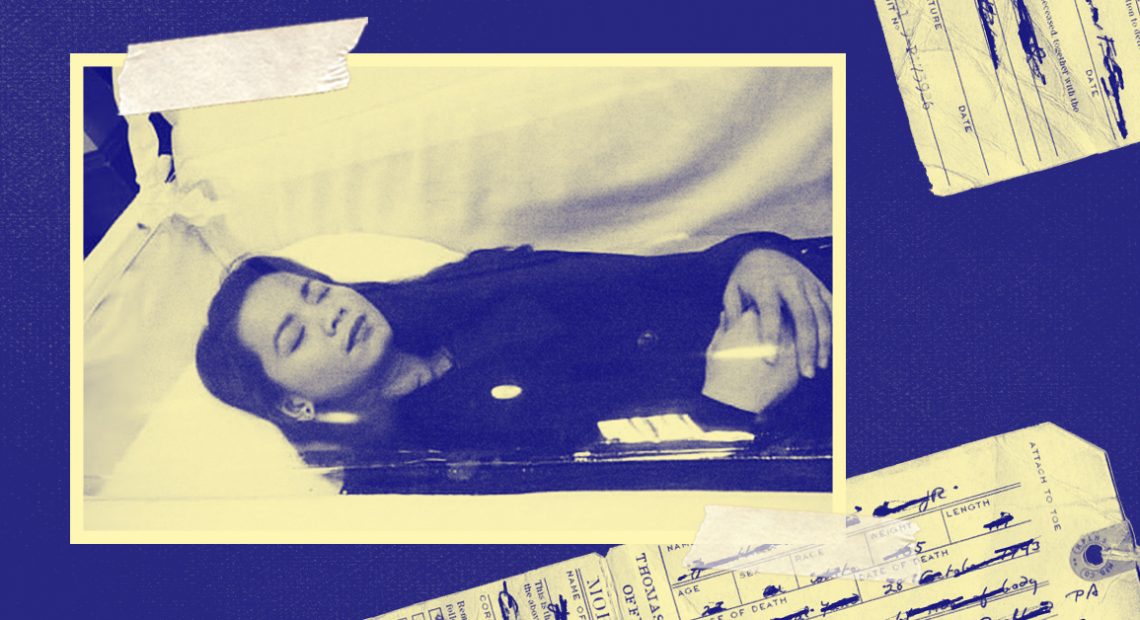The process of embalming begins with a touch. Hidden behind a pair of gloves, the warmth of the embalmer’s hands meets the cold stiff flesh of the dead. This final massage loosens up the cadaver’s rigor mortis (or the stiffening of the body’s muscles upon death).
In the earlier days of her stint as a mortician, Singapore-based Filipino embalmer Danielle Lei Yu, 26, had one of her strangest experiences while doing this process. At the time, she laid a deceased man’s body on the embalming table. She motioned over his hand and began relieving the rigor mortis. All of a sudden, she felt him grip her hand as if they were holding hands. “It freaked me out a bit,” she says.
In cinema, morticians are commonly portrayed as lonely individuals—some with weird kinks, while others have dark secrets—who are placed in an often terrifying narrative.
There is a certain degree of gore, supernatural, and grotesque ascribed to professions related to the dead. In cinema, morticians are commonly portrayed as lonely individuals—some with weird kinks, while others have dark secrets—who are placed in an often terrifying narrative. But as much as Danielle Lei, who has been working in the mortuary industry for almost a year and a half now, wants to share spooky experiences that happen inside the morgue, the day in the life of an embalmer is pretty ordinary.
“Other than that, I haven’t encountered anything weirder. Being an embalmer, working in the morgue, you might expect I should, right?” she says. “I handle so many dead people, but my life is just plain and ordinary—I sleep well at night, eat while we are on break, etc.”
Still, we wonder: What really happens in the morgue?
Have you always wanted to be an embalmer?
Looking back, my mom would always remind me of days where we go to the market. When she buys fish, I would volunteer to clean them and take out the innards—blood, heart, lungs, intestines. I would take my time, investigate it, and usually I would be so fascinated by the heart of the fish.
What were you doing before becoming an embalmer?
I worked as a road manager for a music company in the Philippines. When they gave the notice that the company is closing, I decided to enroll in embalming school.
Where did you take the course? And what was it like?
I took the course at Philippine Embalmers and Undertakers Review and Training Center. It was about three to four months of study and preparation for the licensure exams. The course is composed of anatomy and physiology, microbiology and parasitology, practice of embalming, hygiene and sanitation, and ethics and jurisprudence.
“One time, I had to deal with 11 cases. It was the craziest day—the bodies kept coming one after the other.”
What is a day in a life of an embalmer like?
The arrangement is different and may vary from other companies. Here, we have to report from 8:30 a.m. to 4:30 p.m. There are weeks when I must go back to work if there urgent cases after those hours. The number of cases per day is not absolute. Some days there is none. On other days, we get three to six bodies. One time, I had to deal with 11 cases. It was the craziest day—the bodies kept coming one after the other.
What does an embalmer exactly do?
Embalming is used to delay the process of decay. Most days, I would think that I am embalming this person to make them look presentable to their family members and friends. This will serve as their last image, so I have to make them look at their best.
We relieve the rigor mortis by massaging, bending, flexing the fingers, arms and legs. Then, we set the features of the face. We would ask for photographs from the family to copy how they used to look like. Using an eye-cap to make the eyes look natural and suturing the mouth would help make the deceased look relaxed.
Arterial embalming begins once the expression is set. This is the process of draining the blood vessels while simultaneously injecting embalming chemicals into the arteries. After this, we move on to cavity embalming which involves removing of gas and fluids in the organs using an aspirator and trocar. We would fill the cavity area with concentrated embalming chemicals and soak it for about 15 to 20 minutes.
It’s like human anatomy 101. You get to open the body yourself, see all the body parts (how it looks like inside our bodies, how it is placed), actually touch them, take them out for cleaning, cut them to pieces (for the purpose of better penetration of the formalin), and place them back to the body when you are finished soaking it with chemicals.
Once done, we wash, moisturize, and dress up the body. Makeup is applied last. In summary, the process takes about 45 minutes to one hour, but it could go beyond depending on the case. It would definitely not exceed four hours, though.
Does it really reek?
I had my fair share of the smell when it comes to post mortem cases. It is nothing you can describe. It smells worse than a dead rat or even a dump site. There is a tendency to vomit because the cadaver odor and the chemical odor get mixed up. Luckily, I don’t suffer from that now since we use a full face gas mask over here. Normal cases wouldn’t smell that much except if it has poop or is already decomposing.
What is that one common misconception about dealing with dead bodies that you want to correct?
That in all cases, embalmers take out the organs and dispose them somewhere! It is not true! We are not allowed to take any body parts, internal or external.
What’s the most difficult part of embalming?
Restoration is the most challenging part of embalming. You need to learn how to use make up wax or other tools that can help you achieve how the person used to look like. It would take a lot of time to finish up. This happens when the face is severely damaged or extremely wounded from an accident, fall, or deep wounds or stitches.
” You get to open the body yourself, see all the body parts (how it looks like inside our bodies, how it is placed), actually touch them, take them out for cleaning, cut them to pieces (for the purpose of better penetration of the formalin), and place them back to the body when you are finished soaking it with chemicals”
How does the manner of death affect the process of embalming?
In most cases we handle, the causes are natural death. These cases can all be embalmed but if the body is already decomposing, that’s the point where we have to assess. Decomposing may occur when the person was undiscovered for a period of time or death occurred due to certain circumstances such as drowning, fire, or chemical exposure.
We no longer embalm them because the chemicals won’t be able to flow all throughout the person’s body. The skin will be too soft or charred and sensitive that even the slightest touch would damage it. In such cases, the cadavers will either be placed inside a hermetically sealed casket or be cremated, depending on the family’s decision.

Danielle Lei used to work as an embalmer and funeral directress in the Philippines before moving to Singapore. This photo was taken during her stint here in the Philippines. “I even went inside a coffin for fun (and practice). It wasn’t that bad!”
Have you received any special requests?
In Singapore, it’s very simple. Most families don’t want thick makeup, so it’s a quick process. There would be requests to trim and paint the nails, put a wig on, or dye or cut the hair.
A rather cute request was when we received a letter from a deceased lady. She addressed it to the embalmers, thanking us for handling her on her final journey and requesting to have light makeup and use her own red lipstick.
Speaking of makeup, do you use any special makeup for the deceased?
We do use normal makeup, in the Philippines, my ex-company uses MAC. Here in Singapore, we use Dodge makeup products (intended for the deceased) and other brands that are available in the market (Bobbie Brown, Sephora, etc).
The process would be the same as how you apply makeup on yourself. You start to moisturize, then you apply the first layer of the foundation, you can mix it with another tone so you get the desired color, then you proceed to the eyebrows and lips. It’s really pretty much how a living person would do it.
“…there’s discomfort when you hear stories about the deceased, especially when it’s a suicide case.”
You handle dead bodies every day. Do you still feel any discomfort?
Most bodies I had worked on these days were normal cases: natural deaths, terminal illness, or old age. Then, there are those who committed suicide. I usually stay away from knowing what happened, because there’s discomfort when you hear stories about the deceased, especially when it’s a suicide case.
Once I got to know the story of the guy whom I thought had committed, suicide but it was apparently an accident. He was a construction worker who had fallen from the building he was working on. When his body came to us, his bones were broken so bad I can’t even look at his face. His bones were like puzzle pieces that you have to fix to get his natural look.
Embalming is challenging at first—and maybe when you handle cases that you haven’t handled before. Then again, most of it would be a routine. Those stories that retained with me are the ones that really hit me. As for the others…it’s like saying, “may katawan na naman?”
Does the job pay well?
In Singapore and other foreign countries, yes. However, in the Philippines, it doesn’t unless you own the business itself.
How did your profession change your perception of death?
Death is one of the hardest things to accept. When I was growing up, I was scared to imagine death coming upon me or to someone important to me. Now, I understand it better. It’s more acceptable to me now because it’s natural. Death is the only definite thing that could ever happen to us—we’re all going to lie on the embalming table one day. What would make a big difference is when.
As an embalmer, what did you discover about the human body?
What really amazed me the most is how beautiful our brain looks like! What you see in the books is similar to what you see in person, but to see and touch it is amazing. It feels like tofu.
Death is the only definite thing that could ever happen to us—we’re all going to lie on the embalming table one day. What would make a big difference is when.
If you don’t mind me asking, do you ever imagine what you want to look like when you die?
Personally, if I die, I would prefer to be embalmed in the Philippines (to the company where I used to work and by the hands of the embalmer I know!). But if I die elsewhere, I would prefer not to be embalmed and be buried or cremated as soon as possible.
I even went inside a coffin for fun (and practice). It wasn’t that bad! I even prepared a photo of mine that I would love to be used in my funeral and a song (“If I Die Young” by The Band Perry) that I would want to be played.
*This interview has been edited and condensed. The opinions expressed by the subject are of her own and do not reflect those of the company.
Art by Renz Mart Reyes

























Comments